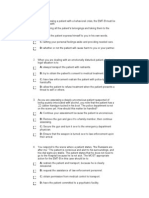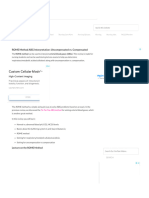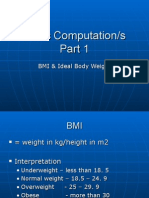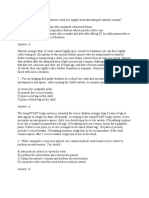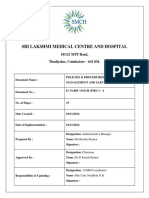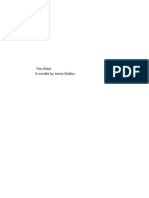Ems Case Study 1
Ems Case Study 1
Uploaded by
Andrews StarkCopyright:
Available Formats
Ems Case Study 1
Ems Case Study 1
Uploaded by
Andrews StarkOriginal Description:
Copyright
Available Formats
Share this document
Did you find this document useful?
Is this content inappropriate?
Copyright:
Available Formats
Ems Case Study 1
Ems Case Study 1
Uploaded by
Andrews StarkCopyright:
Available Formats
EMS Case Study #1
Pulmonary Edema
Instructions
This is a case study training evolution - for the management of a patient
complaining of shortness of breath. The training can be delivered as a practical
medical call with somebody acting as the patient or can be a table top discussion
that allows all personnel to participate at the same level.
The underlying illness is a patient with congestive heart failure. The patient will
present with severe shortness of breath and so the students must actively
engage the patient to obtain an appropriate history.
Students are not to receive copies of the training information; this requires them
to write down the information they obtain from their assessment as if they were in
the field.
Students must treat the patient in accordance with your departments approved
protocols.
This scenario should last between 30 minutes and 1 hour depending on class
size.
Each student shall give a report of their clinical findings, treatments, patients
condition after treatment, and hospital report.
Due to staffing issues an ALS ambulance crew is not available.
Oklahoma State University Fire Service Training
11/2004
P. 1
EMS Case Study #1
Pulmonary Edema
Scenario
Ambulance 317 is dispatched to a residence for a 62 year old male complaining
of shortness of breath. Ambulance is staffed by EMT-basic level trained
personnel only. It is 1900 hours. Response time is 4 minutes. The dispatcher
informs the responding crew that the patient is unable to speak beyond a few
words over the telephone.
On arrival the crew finds the patient sitting in a recliner located in the living room
of his small home. The only other occupant is a small dog that continues to bark
at you from under the sofa. The patient is sitting forward with his hands on his
knees. He is using all of his accessory muscles to breath. His lips are pursed. His
skin color is pale to ashen. Gurgling can be heard and he has a productive cough
that is producing pink tinged sputum.
When asked questions, the patient can only utter yes or no or point.
Patient Information
Mr. Joe Jenkins is a retired welder.
Medications are located on the table next to his recliner, they include: potassium
chloride, Lasix, Lopressor, nitroglycerin, Lanoxin.
The doctors name on the medication bottles is Dr. Mary Vanderhouse.
Assessment Findings
Blood pressure: 180/100
Respiratory rate: 30, shallow
Lung sounds: noted congestion in all lobes.
Oxygen saturation: 80% on home oxygen at 2 liters per minutes
LOC: alert and awake, presents with two word dyspnea.
Pulse: 140 irregular
Pupils: equal and reactive
Physical findings:
HEENT: No JVD, No TD, pursed lips, maintaining his own airway.
CHEST: Lung sounds as noted.
ABD: Soft not tender
EXT: +2 pitting edema at ankles
Oklahoma State University Fire Service Training
11/2004
P. 2
EMS Case Study #1
Pulmonary Edema
Critical Decision Factors
Is this patient in respiratory distress?
What do you feel is the underlying illness?
What can you obtain from patients medications?
Is rapid or emergent transport indicated?
Should the patient be laid supine on the cot or allowed to sit upright.
Key Treatment Issues
Is scene safe to enter?
ABC with history.
High-flow oxygen by a non-rebreather mask at rates greater than 10 lpm.
Rapid transport to hospital.
Monitor oxygen saturation.
If saturations fail to increase, consider assisting ventilations with BVM.
Secure home before leaving.
Notify law enforcement or animal control to take custody of animals or
contact family members to take care of animals.
Conditions During Transport
No increase in oxygen saturation.
Increased shortness of breath.
Patient unable to speak.
Skin color changes to ashen with cyanosis at nail beds.
Vitals Change:
BP: 140/60
Pulse: 150
O2 Sat: 80 with oxygen by mask
Airway: frothy sputum draining from mouth.
Key Treatment Issues
Suction mouth
Recline patient slightly to aid in airway control
Begin to assist ventilation with BVM and 100% oxygen.
Oklahoma State University Fire Service Training
11/2004
P. 3
EMS Case Study #1
Pulmonary Edema
Radio/Hospital Report
The hospital report will vary from student to student but should contain all
pertinent information. An example would be as follows:
This is ambulance 317, we are en route to your facility emergency status
with a 62 year old male patient of Dr. Vanhouse, transporting from patients
residence with a chief complaint of shortness of breath. Patient has a history of
congestive heart failure. On our arrival we found the patient sitting in a recliner,
with his hands on his knees breathing through pursed lips and presenting with
one to two word dyspnea. Patient is on home oxygen at around 2 liters per
minute. We establish high flow oxygen at 15 lpm via a non-rebreather mask.
Initial O2 saturation was 80%. Initial vitals were BP 180/100, pulse 140 and
irregular, respiratory rate at 30 and shallow. Lung sounds were congested with
patient producing pink tinged sputum. En route to your facility patients shortness
of breath increased and patient became unable to speak. We suctioned the
airway and began to assist ventilation using a BVM and 100% oxygen. We will be
at your facility within ten minutes. Do you have any questions or orders?
Case Summary
Many patients that the EMT will encounter are living with congestive heart failure.
In this case our patient was a welder all of his life and exposed to fumes from his
working environment. The EMT should be willing to assist in ventilating a
conscious patient. ALS intervention would have been beneficial but rapid
transport to the hospital was the best choice any medic could have made.
Oklahoma State University Fire Service Training
11/2004
P. 4
You might also like
- Annual Operational Plan 2019Document3 pagesAnnual Operational Plan 2019NEMCLAB57% (7)
- Using SoapDocument1 pageUsing SoapMichael Wilson50% (2)
- Internship ReportDocument2 pagesInternship ReportHitesh Mendiratta100% (5)
- Oral Station Scenario PDFDocument3 pagesOral Station Scenario PDFlotuss45No ratings yet
- Concept Map: Lab Review: Sodium: 136 - 145 Meq/L Potassium: 3.5 - 5.0 Meq/LDocument2 pagesConcept Map: Lab Review: Sodium: 136 - 145 Meq/L Potassium: 3.5 - 5.0 Meq/LKingsMan SSGNo ratings yet
- ChapterDocument39 pagesChapterAdel AlkaliliNo ratings yet
- Medication Template PrednisoneDocument5 pagesMedication Template PrednisoneJudith MeranvilNo ratings yet
- Chapter 36 - Inflammatory & Structural Heart DisordersDocument6 pagesChapter 36 - Inflammatory & Structural Heart Disordersjosie teehNo ratings yet
- Waiters Postpartal Hemorrhage PDFDocument1 pageWaiters Postpartal Hemorrhage PDFTommieNo ratings yet
- Kaiser Permanente HMO 20 California Region NorthernDocument12 pagesKaiser Permanente HMO 20 California Region NorthernAnonymous Wd0qp1X2UANo ratings yet
- Sop For Controlled DrugsDocument75 pagesSop For Controlled DrugsBalaji Pharmacy - GMNo ratings yet
- Emt Fisdap Final Exam Questions and AnswersDocument16 pagesEmt Fisdap Final Exam Questions and AnswersdenisNo ratings yet
- Emt Exam1Document3 pagesEmt Exam1Mary Janine Joy RimanoNo ratings yet
- Chap 1 Intro To Advanced EMT PracticeDocument39 pagesChap 1 Intro To Advanced EMT PracticeAbu YazanNo ratings yet
- Grady EMS Drug List 2017 FINALDocument20 pagesGrady EMS Drug List 2017 FINALThomas LeachNo ratings yet
- Pre Hos TraumaDocument11 pagesPre Hos TraumaGel OmugtongNo ratings yet
- AEMT - Medical Exam PracticeDocument26 pagesAEMT - Medical Exam PracticeEMS DirectorNo ratings yet
- Pharmacology Pretest XDocument7 pagesPharmacology Pretest Xapi-258903855No ratings yet
- Toxicology: by Group 4 2018/2019 Tan Geok Eng Reena DewiDocument59 pagesToxicology: by Group 4 2018/2019 Tan Geok Eng Reena DewiTan Geok EngNo ratings yet
- Medical-Surgical Nursing Review Flashcards - QuizletDocument14 pagesMedical-Surgical Nursing Review Flashcards - QuizletNursyNurse100% (1)
- Medical SurgicalDocument177 pagesMedical SurgicalShannon Mitch Kelly SantosNo ratings yet
- Study Guide For Fluid and Electrolyte ImbalancesDocument5 pagesStudy Guide For Fluid and Electrolyte ImbalancesMandi Goetz HarmonNo ratings yet
- CCRN PCCN Pretest PDB All Rights ReservedDocument8 pagesCCRN PCCN Pretest PDB All Rights Reservedkristine condeNo ratings yet
- Theory ManualDocument34 pagesTheory ManualShalini BaggaNo ratings yet
- Drug Calculations: 1 Hour CEU by Kevin Fabian, NREMT-P Berkeley County EMS, S.CDocument19 pagesDrug Calculations: 1 Hour CEU by Kevin Fabian, NREMT-P Berkeley County EMS, S.CKelvinDavisNo ratings yet
- Drug Nomenclature Suffixes and PrefixesDocument6 pagesDrug Nomenclature Suffixes and PrefixesMariaNo ratings yet
- Basic Life Support Study Guide: Critical Care Training CenterDocument12 pagesBasic Life Support Study Guide: Critical Care Training CenterTODNo ratings yet
- Necrotizing Otitis 2022Document20 pagesNecrotizing Otitis 2022asmashNo ratings yet
- Fisdap Practice PatientDocument2 pagesFisdap Practice Patientapi-463830419No ratings yet
- EMT Review - Baseline Vital Signs and SAMPLE HistoryDocument7 pagesEMT Review - Baseline Vital Signs and SAMPLE HistorymrspatmoreNo ratings yet
- Pyche Lecture : The Johari Window" (Joseph Luft/Harry Ingham, 1963) A Model For SELF-AWARENESS"Document29 pagesPyche Lecture : The Johari Window" (Joseph Luft/Harry Ingham, 1963) A Model For SELF-AWARENESS"mhayaNo ratings yet
- CH 29 - Management of Patients With Structural, Infectious, and Inflmmatory Cardiac DisordersDocument15 pagesCH 29 - Management of Patients With Structural, Infectious, and Inflmmatory Cardiac DisordersPye Antwan Delva100% (2)
- 5 12 Components of Wound Assessment and Documentation-2Document3 pages5 12 Components of Wound Assessment and Documentation-2Jing CruzNo ratings yet
- Normal Ranges Vital Signs 2017Document2 pagesNormal Ranges Vital Signs 2017Elvis Nguyen100% (1)
- Critical Care Transport ParamedicDocument3 pagesCritical Care Transport Paramedicapi-121427596No ratings yet
- Burn Management: Frederick W. Endorf and David AhrenholzDocument5 pagesBurn Management: Frederick W. Endorf and David Ahrenholzwilzmax100% (1)
- Document PDFDocument3 pagesDocument PDFChrisyenDamanikNo ratings yet
- Nremt Study GuideDocument16 pagesNremt Study Guidemilkah mwauraNo ratings yet
- Emergency Exam4Document7 pagesEmergency Exam4Nader Smadi100% (3)
- Handout NSNA Student PresentationDocument14 pagesHandout NSNA Student PresentationlisaNo ratings yet
- Care Plan For CHFDocument6 pagesCare Plan For CHFclarimerNo ratings yet
- Case Study 2Document9 pagesCase Study 2Lupita SolorzanoNo ratings yet
- Pediatric NursingDocument14 pagesPediatric NursingJoanne Pauline100% (1)
- Emergency Exam5Document6 pagesEmergency Exam5Nader SmadiNo ratings yet
- Nursing DiagnosisDocument3 pagesNursing DiagnosisKat Napoleon75% (4)
- Test 1 - Spec Pops - Beers Criteria Guided QuestionsDocument2 pagesTest 1 - Spec Pops - Beers Criteria Guided QuestionsvevenaneathnaNo ratings yet
- Emergency Exam6Document5 pagesEmergency Exam6Nader Smadi100% (1)
- Drug Study Guide Calculation PDFDocument49 pagesDrug Study Guide Calculation PDFHarley Justiniani Dela CruzNo ratings yet
- Basic Prov Itls Study Guide 7thedDocument12 pagesBasic Prov Itls Study Guide 7thedDave Amarasinghe0% (1)
- Wound Care NursingDocument1 pageWound Care NursingFatima AbubakarNo ratings yet
- ROME Method ABG Interpretation - Uncompensated vs. CompensatedDocument6 pagesROME Method ABG Interpretation - Uncompensated vs. CompensatedBhavaniNo ratings yet
- GT Task 1, Letter: GT Writing Samples by Dr. Murray Heasley (Former Examiner)Document37 pagesGT Task 1, Letter: GT Writing Samples by Dr. Murray Heasley (Former Examiner)Kezia JacotNo ratings yet
- Baseline Vital Signs, Monitoring Devices, and History TakingDocument100 pagesBaseline Vital Signs, Monitoring Devices, and History TakingLim Jun Bin100% (1)
- Chapter 6 Care of The Patient Experiencing Shock or Heart FailureDocument49 pagesChapter 6 Care of The Patient Experiencing Shock or Heart FailureJennifer KellerNo ratings yet
- BLS SummaryDocument2 pagesBLS Summaryreyes markNo ratings yet
- Basic Drug Computations Part 1Document8 pagesBasic Drug Computations Part 1Carl Elexer Cuyugan Ano100% (4)
- EMS Prehospital Care ManualDocument315 pagesEMS Prehospital Care ManualRhonda Bush100% (1)
- AbbreviationDocument19 pagesAbbreviationJayson NatividadNo ratings yet
- AEMT - Operations Exam PracticeDocument25 pagesAEMT - Operations Exam PracticeEMS Director100% (1)
- Pulmonary TraumatologyDocument15 pagesPulmonary Traumatologynoor88No ratings yet
- 50 Shades of Practice QuestionsDocument11 pages50 Shades of Practice QuestionsAmie Ray100% (1)
- High Altitude Sickness, A Simple Guide To The Condition, Diagnosis, Treatment And Related ConditionsFrom EverandHigh Altitude Sickness, A Simple Guide To The Condition, Diagnosis, Treatment And Related ConditionsNo ratings yet
- Leaping the Hurdles: The Essential Companion Guide for International Medical Graduates on their Australian JourneyFrom EverandLeaping the Hurdles: The Essential Companion Guide for International Medical Graduates on their Australian JourneyNo ratings yet
- Infection Control Webinar 16022010Document88 pagesInfection Control Webinar 16022010shyamchepurNo ratings yet
- Resume KathyDocument3 pagesResume Kathyapi-314534027No ratings yet
- Journal: Lyceum Northwestern UniversityDocument4 pagesJournal: Lyceum Northwestern UniversityBrian Montales BaggayanNo ratings yet
- Psychologist or School Psychologist or Therapist or CounselorDocument2 pagesPsychologist or School Psychologist or Therapist or Counselorapi-79222085No ratings yet
- Cannabis in Papua New GuineaDocument18 pagesCannabis in Papua New GuineaDavid McDonaldNo ratings yet
- SiD 4.3.3.12 at 7 June 2011Document2 pagesSiD 4.3.3.12 at 7 June 2011Dr-Mohamed KandeelNo ratings yet
- On The Effectiveness of Ayurvedic Medical Treatment - Humoural Pharmacology, Positivistic Science, and SoteriologyDocument24 pagesOn The Effectiveness of Ayurvedic Medical Treatment - Humoural Pharmacology, Positivistic Science, and SoteriologyBrad YantzerNo ratings yet
- Lesson PlansDocument626 pagesLesson PlansAngie Montala Reana100% (2)
- Letters For PsychiatyDocument14 pagesLetters For PsychiatyRhalfNo ratings yet
- Policies and Procedures On Facility Management And-Safety PDFDocument15 pagesPolicies and Procedures On Facility Management And-Safety PDFshubham solanki100% (2)
- Project Management Exercise - Waterfall BackgroundDocument6 pagesProject Management Exercise - Waterfall BackgroundShaun HazardNo ratings yet
- Labour and Delivery 2019Document28 pagesLabour and Delivery 2019Heti PrastiwiningsihNo ratings yet
- Rita All CVDocument2 pagesRita All CVapi-250418097No ratings yet
- Comparison of General and Regional Anesthesia in Morbidly Obese Patient Case Report Ijdmd 18Document4 pagesComparison of General and Regional Anesthesia in Morbidly Obese Patient Case Report Ijdmd 18Djustiela KarrangNo ratings yet
- ANSAP Hosp. Contact No.Document8 pagesANSAP Hosp. Contact No.Lalaine ArenasNo ratings yet
- IMNCIDocument31 pagesIMNCIJaya Prabha100% (3)
- The WitchDocument27 pagesThe WitchJonny BolducNo ratings yet
- Kalie McCartin CV/ResumeDocument2 pagesKalie McCartin CV/ResumeKalie MccartinNo ratings yet
- Mou of East West TpaDocument13 pagesMou of East West Tpamalayanur rama chandraNo ratings yet
- Northland Freeland Health Care PitchDocument144 pagesNorthland Freeland Health Care Pitchyel14No ratings yet
- Almost Famous Women Stories by Megan Mayhew BergmanDocument22 pagesAlmost Famous Women Stories by Megan Mayhew BergmanSimon and SchusterNo ratings yet
- Qibah General Hospital Qibah, Al Gassim, Ksa Infection Control DepartmentDocument2 pagesQibah General Hospital Qibah, Al Gassim, Ksa Infection Control DepartmentSherina EddingNo ratings yet
- CDPH Survey With Plan of CorrectionDocument67 pagesCDPH Survey With Plan of CorrectionJames WardNo ratings yet
- CIR vs. ST Lukes DigestDocument2 pagesCIR vs. ST Lukes DigestKath Leen100% (4)
- Example Dialogue AdmissionDocument3 pagesExample Dialogue AdmissionAthiyyah KamilahNo ratings yet
- Brief COPE Coping Strategies of Nurses QuestionnaireDocument5 pagesBrief COPE Coping Strategies of Nurses Questionnairegrandville cabildoNo ratings yet











































